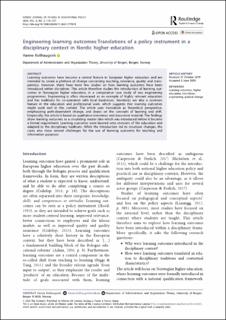| dc.contributor.author | Kvilhaugsvik, Hanne | |
| dc.date.accessioned | 2021-06-10T09:44:29Z | |
| dc.date.available | 2021-06-10T09:44:29Z | |
| dc.date.created | 2020-06-22T11:17:02Z | |
| dc.date.issued | 2020 | |
| dc.identifier.issn | 2002-0317 | |
| dc.identifier.uri | https://hdl.handle.net/11250/2758785 | |
| dc.description.abstract | Learning outcomes have become a central feature in European higher education and are intended to create a plethora of change concerning teaching, relevance, quality and transparency. However, there have been few studies on how learning outcomes have been introduced within disciplines. This article therefore studies the introduction of learning outcomes in Norwegian higher education, in a comparative case study of two engineering programmes. Engineering is often showcased as an example of highly relevant education and has traditions for co-operation with local businesses. Standards are also a common feature in the education and professional work, which suggests that learning outcomes might work well in this context. The article uses translation as theoretical perspective, emphasizing path-dependent change, and draws on the concepts of layering and drift. Empirically, the article is based on qualitative interviews and document material. The findings show learning outcomes as a circulating master idea which was introduced before it became a formal requirement. Learning outcomes were layered onto revisions of the education and adapted to the disciplinary traditions. While the introduction led to structural changes, the cases also show several challenges for the use of learning outcomes for teaching and information purposes. | en_US |
| dc.language.iso | eng | en_US |
| dc.publisher | Taylor & Francis | en_US |
| dc.rights | Navngivelse-Ikkekommersiell 4.0 Internasjonal | * |
| dc.rights.uri | http://creativecommons.org/licenses/by-nc/4.0/deed.no | * |
| dc.title | Engineering learning outcomes: Translations of a policy instrument in a disciplinary context in Nordic higher education | en_US |
| dc.type | Journal article | en_US |
| dc.type | Peer reviewed | en_US |
| dc.description.version | publishedVersion | en_US |
| dc.rights.holder | Copyright 2020 the author | en_US |
| cristin.ispublished | true | |
| cristin.fulltext | original | |
| cristin.qualitycode | 1 | |
| dc.identifier.doi | 10.1080/20020317.2020.1779578 | |
| dc.identifier.cristin | 1816566 | |
| dc.source.journal | Nordic Journal of Studies in Educational Policy | en_US |
| dc.source.pagenumber | 116-127 | en_US |
| dc.identifier.citation | Nordic Journal of Studies in Educational Policy. 2020, 6 (2), 116-127. | en_US |
| dc.source.volume | 6 | en_US |
| dc.source.issue | 2 | en_US |

